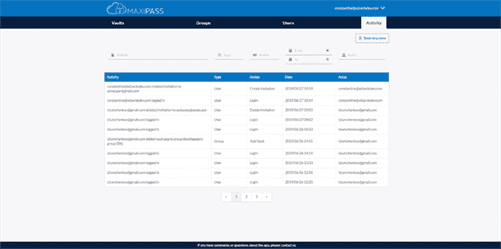This is possible due to web services’ universal communication protocols. Traditionally, API referred to an interface connected to an application created with any of the low-level programming languages, such as Javascript. They are typically built for HTTP, resulting in developer-friendly interfaces that are easily accessible and widely understood by applications written in Java, Ruby, Python, and many other languages. These “smart devices” offer added functionality, such as internet-enabled touchscreens and data collection, through APIs. For example, a smart fridge can connect to recipe applications or take and send notes to mobile phones via text message.
Alternatively, the service can be called automatically as part of a workflow, and such experimental chaining of eHabitat with other Web-based models such as conservation planning algorithms and climate simulators is planned and ongoing. The largest potential benefit from the Model Web is likely to be the practical and easy re-use of basic modeling components for different purposes. We believe that the granularity of the models expected to interact with each other is a critical factor in any operational version of the Model Web. A higher granularity is likely to generate more reusable elementary services, greater control for the users composing those services and thus, ultimately, more complex and useful modeling chains. Another milestone was the setting up by Nativi et al. (2009) of an ecological niche modeling framework built around OpenModeller2 (Muñoz et al., 2011), a popular tool for ecological niche modeling.
The names x and y are not nearly

as meaningful as sReply, sHello and sHowAreYou. In a more complex method,
Accelerating API Quality Through Testing
with dozens of variables, having the ability to easily identify the meaning
of a variable name will make you a more efficient programmer. Once you are working in a larger project
and have multiple files open, it may become useful to leave the File Navigator
window open as a docked window. If the File Navigator is not already open,
- So when one software system needs one particular report/data, it would go to the UDDI and find out which other systems it can contact for receiving that data.
- A Web service is a service that can be shared across the World Wide Web (i.e., the information-resources space that is accessible via the internet).
- The parameter passed into the onfetch handler, FetchEvent represents a fetch action that is dispatched on the ServiceWorkerGlobalScope of a ServiceWorker.
- Dynamic maps or layers, for example, are retrieved from the data source at the time they’re requested by the user.
- So, if for example, sName contains “John”,
this would move “Hello, John, how are you today?” to sReply.
you can open it by clicking on the File
web services
Navigator toolbar button. To switch back to the visual designer, you
can click the Code Toggle between Code
Editor and Designer Views toolbar button again. You can also press
F7 to toggle between the designer

and the code editor for any given file.
Read more
about this in the Workspace
Explorer topic in the Studio
book. If you have questions about services security and the type of access configured for the services authored within your organization, don’t hesitate to contact SSP and ask what the ArcGIS Online Jumpstart Package can do for you. Creating ArcGIS Web services entails designing and authoring types of information that others will find valuable AND publishing it in a manner that makes it easy for them to access and consume for review and analysis. Web services also tend to use the XML format to encode data, while APIs generally may use any language to store data.
What is a Web Service?
Let us take a look at some of the most common examples that we have come across in our experience. Thanks to e-commerce systems, producers and suppliers of goods and services can offer their products to clients online, accept and process orders, manage the status of orders, etc. Depending on a business’s particular goals and context, here are some of the most common types of web apps an organization may want to develop.
Implementing functional test for your web service early in the software development cycle speeds up development, improves quality and reduces risks towards the end of the cycle. A directory called UDDI (Universal Description, Discovery, and Integration) defines which software system should be contacted for which type of data. So when one software system needs one particular report/data, it would go to the UDDI and find out which other systems it can contact for receiving that data. Once the software system finds out which concept of mobile web app development other systems it should contact, it would then contact that system using a special protocol called SOAP (Simple Object Access Protocol). The service provider system would first validate the data request by referring to the WSDL file, and then process the request and send the data under the SOAP protocol. In practice, a web service commonly provides an object-oriented web-based interface to a database server, utilized for example by another web server, or by a mobile app, that provides a user interface to the end-user.

Both APIs and web services are technologies that enable the transfer of data between separate software applications. API is an interface that exposes an application’s data to outside software, whereas web applications are one type of API with stricter requirements. These requirements include network communication, SOAP as the primary protocol, and less accessibility for the public. Keep in mind, however, that web services require a network to interact, and this networked communication is usually achieved thanks to SOAP.
A common approach to making that happen is with a service-oriented architecture. The above will respond with “Hello World” if the path matches /hello-world, and “42” if it matches /the-answer. Note that the composed router functions are evaluated in order, so it makes sense to put specific functions before generic ones. Syberry has significantly improved our existing platform, and they continue demonstrate their dedication to our business goals and needs by making thoughtful suggestions for enhancements. The Syberry team is communicative and reliable, mitigating all our concerns about outsourcing software development. They communicated well with our team throughout the process, breaking down steps and utilizing a streamlined management system to keep everyone in the loop at all times.
The main trade-off is that SOAP is more strict in its requirements than RESTful design, making it more code-heavy and process-intensive. That’s why a web service may incorporate principles from REST or XML-RPC. Both web services and APIs are vital to modern software architecture, but developers need to remember that while these terms have some overlap, they are fundamentally not the same. The team contributed engineers to follow an established roadmap to perform updates and add features.

Taking over for another vendor, we served as the ongoing software engineering partner for an energy company’s cloud-based platform. The company provided scoping, development, testing, and deployment services. Syberry explained their process thoroughly and accommodated to scope changes effortlessly. Their stellar project management, highly responsive communication, and proactive attitude set them apart. Additionally, web services can be used to link data between different platforms.